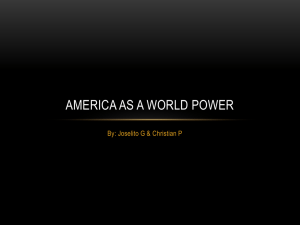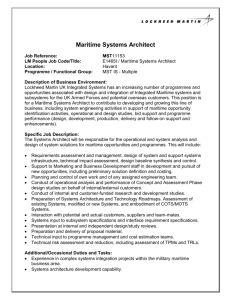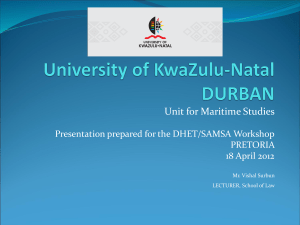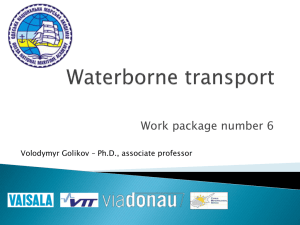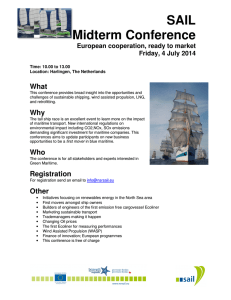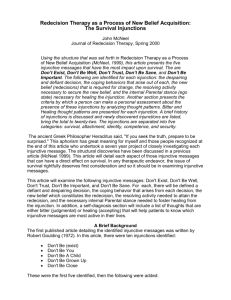Injunction Relief Under Panamanian Admiraltiy Law (Transcript)
advertisement
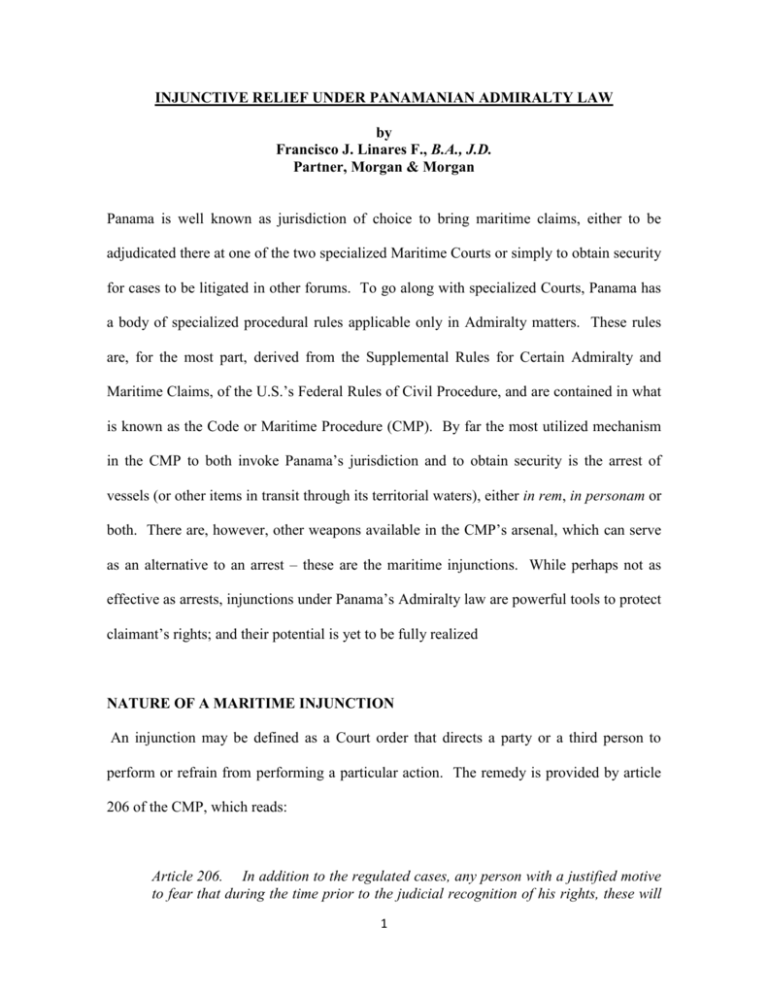
INJUNCTIVE RELIEF UNDER PANAMANIAN ADMIRALTY LAW by Francisco J. Linares F., B.A., J.D. Partner, Morgan & Morgan Panama is well known as jurisdiction of choice to bring maritime claims, either to be adjudicated there at one of the two specialized Maritime Courts or simply to obtain security for cases to be litigated in other forums. To go along with specialized Courts, Panama has a body of specialized procedural rules applicable only in Admiralty matters. These rules are, for the most part, derived from the Supplemental Rules for Certain Admiralty and Maritime Claims, of the U.S.’s Federal Rules of Civil Procedure, and are contained in what is known as the Code or Maritime Procedure (CMP). By far the most utilized mechanism in the CMP to both invoke Panama’s jurisdiction and to obtain security is the arrest of vessels (or other items in transit through its territorial waters), either in rem, in personam or both. There are, however, other weapons available in the CMP’s arsenal, which can serve as an alternative to an arrest – these are the maritime injunctions. While perhaps not as effective as arrests, injunctions under Panama’s Admiralty law are powerful tools to protect claimant’s rights; and their potential is yet to be fully realized NATURE OF A MARITIME INJUNCTION An injunction may be defined as a Court order that directs a party or a third person to perform or refrain from performing a particular action. The remedy is provided by article 206 of the CMP, which reads: Article 206. In addition to the regulated cases, any person with a justified motive to fear that during the time prior to the judicial recognition of his rights, these will 1 suffer immediate and irreparable risk, may petition the Judge for such conservative or protective measures which are most appropriate to provisionally secure, according to the circumstances, the effectiveness of a decision on the merits. The petitioner will file his petition attaching summary evidence1 and, in addition to this, the corresponding counter-security for damages, which in no event will be less than US$1,000.00 nor more than US$50,000.00. In the cases of prohibitions to sale and encumber vessels or other assets, counter-security will be no less than US$10,000.00. The petition will be processed and decided, as it pertains, according to the rules of this chapter. Let us see how this compares with the typical Admiralty arrest (which is regulated by article 166 of the CMP). Firstly, as in the case of an arrest, the maritime injunction is a precautionary measure – that is, it is tool to secure the effectiveness of a future reasonably probable result of litigation. According to the actions ordered, injunctions may be prohibitive or mandatory. In this, injunctions differ from arrests, which are fundamentally prohibitive measures that place an item out of commerce and at the orders of the Court. Like arrests, Admiralty injunctions are ex parte measures – that is, the applicant appears before the Judge, without notice to the affected party. Injunctions are subject to the Judge’s entire discretion – this is what makes them distinctive, and quite different from arrests, which have a very defined structure. Finally, whereas an arrest order is always directed against a party or an agent (i.e. – a bailee), an injunction may be directed specifically against not only the parties to the litigation (or their agents) but against third parties not directly involved in the dispute. REQUIREMENTS “Summary evidence” is that obtained by the petitioner without a Court’s intervention. As to its probative weight, the Supreme Court has stated that the “summary evidence” requirement is satisfied by furnishing prima facie evidence (see Cemar Shipping Inc. v. Nobelium Finance, Inc. et al. [S.Ct./1C/24.7.03]). 1 2 Article 206 of the CMP had a counterpart in article 569 of the Judicial Code2. Even though injunctive relief existed in Admiralty proceedings prior to its inclusion into our Judicial Code, the jurisprudence from our higher Courts (including the Supreme Court) has been much more extensive on the latter as opposed to the former. According to the jurisprudence there is on injunctions generally, the following basic requirements have to be met in order to obtain one. First, the petitioner must provide sufficient evidence showing that she has a case on the merits with reasonably good prospects of success (what is called the fumus boni iuris – the appearance of a good right of claim). Secondly, the petitioner must persuade the Judge that, but for the granting of the injunction, her rights will be significantly prejudiced and that, because of this, the remedy must be ordered without delay (what is called the periculum in mora – the danger in the delay). Finally, the petitioner must post counter-security, as required by the Judge and under the parameters established by article 206 of the CMP. The predecessor provision to article 206 of the CMP gave the Judge unbridled discretion to fix counter-security. However, the CMP was reformed in 2009, and the Admiralty injunction was revised to place strict parameters within which the Judge can exercise her discretion in establishing counter-security3. Panama’s Admiralty injunction, then, is somewhat similar to the UK’s Mareva Injunction, in that it is an ex parte interlocutory remedy available to plaintiffs, aimed at preventing defendants from dissipating its assets, prior to a final ruling on the merits. Like the Mareva injunction, the CMP injunction requires the petitioner to persuade the Court that The Judicial Code is Panama’s Code of Civil Procedure, applicable primarily to non-maritime Civil and Commercial disputes. 3 With the practical effect of reducing the burden on the petitioner. Prior to the 2009 reform, Maritime Judges usually demanded 20% of the claim amount as counter-security for an injunction. 2 3 there is great danger of defendants rendering a potential judgment worthless, and that she has a reasonably good arguable claim on the merits. Likewise, the CMP injunction is comparable – insofar as the requirements the applicant has to meet – to a temporary restraining order, under Rule 65 of the US’ Federal Rules of Civil Procedure. AVAILABILITY Injunctions in Panama are now available only in causes of actions governed by the CMP4. This of course means that anyone seeking injunctive relief in Panama must be able to invoke the Admiralty jurisdiction of the Maritime Courts. According to article 19 of the CMP, the Maritime Courts’ Admiralty jurisdiction covers acts pertaining to “maritime commerce, transport and traffic occurring within the territory of the Republic of Panama”. The Maritime Courts may also have jurisdiction over maritime causes of action arisen outside the territory of Panama, whenever an arrest is conducted within the Courts’ territorial jurisdiction5. Also, the Maritime Courts have Admiralty jurisdiction over all maritime causes of action involving a vessel or vessels flying the Panamanian flag or, more generally, whenever Panamanian substantive law is applicable to the dispute (either by contract or ex proprio vigore). Structurally, Admiralty injunctions seem to be designed as a remedy for in personam causes of action. There is nothing in the CMP that says they are not available in in rem causes of action as well. As a practical matter, however, it is often difficult to make the case for an injunction in an in rem cause of action, because the in rem right itself often provides a sufficient remedy to the petitioner, thereby negating the 4 Article 569 of the Judicial Code was abrogated in March, 2013. Injunctions per se are on longer obtainable through ordinary commercial proceedings in Panama. 5 Something similar to a Rule B attachment under the US’ Supplemental Rules for Certain Admiralty and Maritime Claims. 4 periculum in mora element that must be shown to the Judge6. Finally, provided the Court has jurisdiction as per article 19 of the CMP, the injunction may be ultimately aimed at affecting a defendant located inside or outside the territorial jurisdiction of the Court. CURRENT USES In practice, Admiralty injunctive relief under the CMP is used to prevent the sale, deletion and/or encumbering of Panamanian registered vessels7. How does this most commonly invoked injunctive relief work in practice? A party seeking an injunction generally8 must file a complaint in the Maritime Courts of Panama and, in that context, make an application for an injunction. In other words, in order to obtain Admiralty injunctive relief, the petitioner typically has to commence proceedings on the merits in Panama. The plaintiff/applicant must furnish prima facie evidence of her claim, so as to show that she has a reasonably good case on the merits. She must show that the vessel or vessels targeted for injunction are registered in Panama. Most importantly, the plaintiff/applicant must provide good evidence that, but for the granting of the injunction, her rights will suffer immediate and irreparable risk. This is the periculum in mora element, one that often is the hardest to prove. Evidence of the periculum in mora may be market news or reports to the effect that the defendant is selling off assets, due to bankruptcy or otherwise. On this element, the jurisprudence has elaborated what may be termed as the “one-ship-owning6 In rem rights, by attaching to vessels irrespective of subsequent ownership transfers, often prevent the very asset dissipation that injunctions aim at. A plaintiff invoking a maritime lien against a particular vessel does not generally have to worry about who the actual owner of the vessel is, whenever the vessel is physically arrested. 7 This has been called a “flag arrest” in a recent article published in Tradewinds. These injunctions, however, do not affect a vessel’s operation or her owners’ capacity to conduct commerce with her. This is very different from an arrest, which immediate effect is to produce a physical detention and place the item arrested out of commerce. To call an injunction of this nature a “flag arrest” is misleading. 8 But not always – Admiralty injunctions may be obtained without filing substantive proceedings when used to gather evidence. 5 company presumption”. Starting with the precedent in Cemar Shipping Inc. v. Nobelium Finance Inc. [S.Ct./1C/24.7.03]9, following with the decision in Louis Dreyfus Commodities Suisse S.A. et al. v. Fioralba Shipping Co. Ltd. [S.Ct./1C/15.6.12], and culminating with the ruling in Cockett Marine Oil Ltd. v. Tribute Shipholdings, S.A. [S.Ct./1C/23.4.14]10, the Supreme Court has made it clear that an applicant satisfies the periculum in mora requirement by showing that the defendant is a one-ship-owningcompany. Article 206 of the CMP gives broad discretion to the Judge to frame such injunctive relief that most adequately fits the need to prevent the possibility of the defendant making an eventual ruling against her worthless. There is, however, a form of injunctive relief which is narrowly defined in its scope and applicable only in very specific situations. This is provided by article 512 of the CMP. Under article 512 of the CMP, a party that has provided security to her counterpart may apply to the Judge for an injunction ordering opponent’s insurance company to provide adequate security to cover a counter-claim. This remedy is a legislatively mandated injunctive relief, but it is applicable only in cases of collisions. Lastly, Admiralty injunctions may be employed as and evidence gathering tool – that is, as a type of Anton Piller Order11. Thus, for example, in cases of General Average, or whenever there is the need to gather evidence prior to commencing formal substantive 9 The lower Court had granted the injunction, but the Supreme Court reversed fundamentally because plaintiffs failed to “show that the vessel constitutes the only asset belonging to the defendant company”. 10 In both the Louis Dreyfuss and Cockett Marine cases, when analyzing the periculum in mora element, the Supreme Court stressed the fact that the applicants had shown that the defendants were one-ship-owningcompanies. 11 Or, more appropriately, a search order under Section 7 of the UK’s Civil Procedure Act 1997. 6 proceedings – in Panama or abroad – the Maritime Courts have traditionally afforded injunctive relief, to allow a party to collect critical evidence, take testimonies and conduct surveys necessary to prevent crucial information from being lost. When used as an evidence gathering tool, a petition for Admiralty injunctive relief need not form part of a substantive claim filed in Panama. REMEDIES AGAINST AN INJUNCTION Unlike in the case of a wrongful arrest, where the CMP provides – under very specific circumstances – that a person with an interest in the property is entitled to a prompt hearing where the arresting party must show cause why the arrest should not be vacated, there are very limited things that may be done to effectively challenge an injunction. An appeal against the order granting the injunction is – in most cases – the best, if not the only, avenue to challenge an injunction granted without sufficient prima facie evidence of the fumus boni iuris and/or periculum in mora elements. Standard of review on appeal is stringent in maritime cases – the Appellate Court may only visit issues of law, and cannot review the lower Court’s factual findings unless they are clearly erroneous. If at least one of the conditions listed in article 19 of the CMP is not present, the party suffering the injunction may file a nullity motion due to lack of jurisdiction. Lastly, provided that the injunction is unlawfully granted and its effects outrageous enough, there is always the possibility of filing a constitutional challenge (known as an “Amparo de Garantías”), for violation of the due process clause of Panama’s Constitution12. 12 These challenges are always something of a long shot. Usually, a party has to exhaust all possible recourses against a judicial decision infringing the Constitution, in order to even have standing to file a 7 ABUSES The broad powers vested on Maritime Judges by article 206 of the CMP and the fact that injunctions are granted ex parte can be subject to misuse. In cases involving injunctions preventing the sale and deletion of vessels, the process is often abused by astutely crafted complaints aimed at achieving, in practice, the subreptitious piercing of corporate veils. The end result of this is to effectively affect sister ships wholly unconnected with the relevant dispute, other than by the fact that they belong to a company in the same economic group as the appropriate defendant. Because our CMP’s lack of a summary remedy for a wrongful injunction, the affected party if left with only two viable options: (a.) either secure the claim fully, and thereby lift the injunction; or (b.) appeal he injunction order, and withstand its effects while the appeal is pending13. In fairness, though, Maritime Courts have been traditionally circumspect in wielding their injunctive powers. That was not the case with Civil Courts, which used article 569 of the Judicial Code often and recklessly. After years of ever more exuberant excesses, in March, 2013, Panama’s Legislative Assembly suddenly repealed article 569 of the Judicial Code. Thus, nowadays the only commercial Courts in Panama with the power to issue injunctions proper are the Maritime Courts. challenge. For this reason, Constitutional challenges are often not a good remedy from a practical point of view. Nevertheless, when the violation of due process is extremely abusive, with potentially devastating consequences for the victim, the Supreme Court has agreed to hear Constitutional challenges immediately under a doctrine known as the “the Effective Remedy” principle (see for instance Union Pak de Panama, S.A. et al. v. Ministry of Labour. [S.Ct./En Banc/ 13.05.05] 13 Maritime appeals may take a long time be resolved. Up until very recently all maritime appeals were heard by the Supreme Court (which also heard all of the non-maritime civil and commercial cases). New Maritime Courts of Appeals have been inaugurated, and this is expected to significantly reduce the backlog on appeals. 8 POTENTIAL FUTURE DEVELOPMENTS That said, there might be legitimate expansions in the areas where injunctive relief has traditionally been granted by Panama’s Maritime Courts. When considering possible new developments in the evolution of the Admiralty Courts’ injunctive power, in light of the current trends in Admiralty litigation, two questions come to mind: i) could it be used to force the posting of adequate security?; and ii.) could it be used as an anti-suit injunction? Regarding the first question, it seems that this may be a legitimate extension of the Admiralty injunctive power. The power to issue a mandatory injunction requiring a party to post security already exists in our maritime procedure, by virtue of article 512 of the CMP. Article 34 of the CMP provides for the use of analogy, whenever a particular issue is not dealt with explicitly by our procedural rules. What is then to prevent these types of mandatory injunctions from being granted beyond collision cases?14 There seems to be room for expansion here, although one would only expect this to take place when a very unique case – with circumstances requiring out of the ordinary remedies – comes before the Maritime Courts. Run-of-the-mill scenarios will certainly not make Maritime Judges trail blaze. The second question is perhaps the more interesting one, as the newly reformed CMP has placed special emphasis on the subject of maritime arbitration and the enforcement of 14 In fact, prior to the abolition of article 569 of the Judicial Code, civil Courts would issue injunctions ordering a party to post security (see Saraya International, S.A. v. Aveiro Finance Inc. et al [First App.Ct./1st Dist./ 19.01.12]). 9 arbitration clauses for Panama. Articles 20 and 22 of the CMP mandate that the Maritime Courts stay proceedings whenever they are confronted with a clause to arbitrate in Panama. Article 202 of Panama’s Constitution recognizes that the administration of justice is also conducted through arbitration. Last, but not least, article 32 of the Constitution – Panama’s due process clause – states that no one is to be judged but by a competent authority and in accordance with due process of law. The question of whether the Maritime Courts can issue an anti-suit injunction against a party within the jurisdiction that – in violation of an agreement to arbitrate in Panama – had filed suit outside of the jurisdiction, has simply not been put forth yet for their decision. Presently, there is not a lot maritime arbitration in Panama, but that is bound to change. There is now a maritime arbitration center in Panama15, and it is more often the case that maritime contracts are being entered with clauses referring disputes to arbitration in Panama. The time will come, in the not too distant future, when our Courts will use article 206 of the CMP to provide an effective remedy to a party that is suffering vexatious litigation outside of Panama, in flagrant violation of an agreement to arbitrate in Panama16. CONTEMPT The teeth of any form of injunction relief are, of course, the consequences that may befall on the party that disobeys them. In Panama, these consequences are: 1) imprisonment for 15 Centro de Conciliación, Mediación y Arbitraje Marítimo de Panamá, also known as CECOMAP. In Saraya International, S.A. v. Aveiro Finance Inc. et al [First App.Ct./1st Dist./ 19.01.12], the lower Court had issued what was in effect an anti-suit injunction, prohibiting defendants from bringing action in certain Courts in Panama. Though the Appelate Court reversed this, it did so on the grounds of the due process clause of our Constitution. The question is different when the injunction seeks to order a party to cease proceedings abroad, and file action in the appropriate forum, as required by the principles informing the due process clause of our Constitution. 16 10 up to one year, 2) monetary sanctions and 3) damages resulting from the party’s contempt of Court. These penalties have, so far, seemingly sufficed to keep parties honest. It is the case, however, that under current practice almost all injunctions issued are directed to the Director General of the Merchant Marine – a public servant, who will not disobey a Court willingly. As the scope of the Admiralty injunctive relief expands, penalties for contempt will probably have to follow suit, if the remedy is to remain effective. CONCLUSION A powerful tool to safeguard a party’s litigation position, an Admiralty injunction can be used in Panama either to secure an eventual recovery after a decision on the merits or to collect crucial evidence indispensable to a party’s case. Yet, Panamanian Maritime Judges have not really exploited to the fullest the possibilities afforded by their injunctive powers, provided by article 206 of the CMP. It is to be expected that such injunctive powers will expand to provide new forms of remedies to maritime claimants. 11
